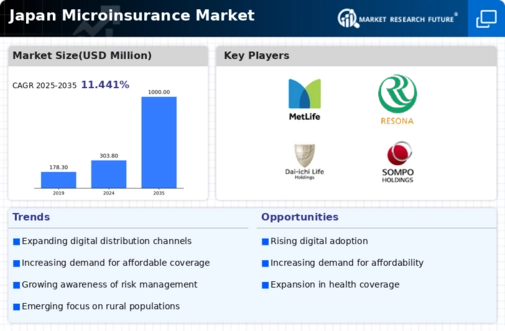Expansion of Digital Platforms
The proliferation of digital platforms in Japan is significantly influencing the microinsurance market. With the rise of mobile technology and internet accessibility, insurance providers are increasingly leveraging digital channels to reach underserved populations. Reports suggest that over 80% of Japanese households own smartphones, facilitating the distribution of microinsurance products through mobile applications and online platforms. This shift not only enhances accessibility but also reduces operational costs for insurers, allowing them to offer more competitive pricing. As a result, the microinsurance market is likely to witness a surge in customer engagement and policy uptake. The convenience of digital transactions, coupled with the ability to provide tailored products, positions the microinsurance market favorably in a rapidly evolving technological landscape.
Increased Competition Among Insurers
The microinsurance market in Japan is experiencing heightened competition among insurers, which is driving innovation and improving product offerings. As more companies enter the market, they are compelled to differentiate themselves through unique value propositions and competitive pricing strategies. This competitive landscape is beneficial for consumers, as it leads to a wider array of choices and potentially lower premiums. Recent analyses indicate that the number of microinsurance providers in Japan has increased by approximately 25% over the past five years, reflecting a growing interest in this segment. The microinsurance market is thus likely to evolve rapidly, with insurers continuously seeking to enhance their services and meet the diverse needs of the population.
Demographic Shifts and Aging Population
Demographic shifts, particularly the aging population in Japan, are significantly impacting the microinsurance market. As the proportion of elderly individuals rises, there is an increasing need for insurance products that cater specifically to this demographic. Older adults often face unique risks, including health-related issues and long-term care needs, which traditional insurance may not adequately address. The microinsurance market is thus presented with an opportunity to develop specialized products that offer coverage for these specific risks. Recent data indicates that by 2030, nearly 30% of Japan's population will be over 65 years old, suggesting a growing market for tailored microinsurance solutions. This demographic trend is likely to drive innovation and expansion within the microinsurance market.
Rising Awareness of Financial Protection
The increasing awareness of financial protection among the Japanese population is a crucial driver for the microinsurance market. As individuals become more informed about the risks associated with health, accidents, and natural disasters, the demand for affordable insurance solutions rises. Recent surveys indicate that approximately 60% of Japanese citizens express a desire for insurance products that cater to their specific needs, particularly in low-income segments. This growing consciousness about financial security is likely to propel the microinsurance market forward, as more people seek coverage that is both accessible and tailored to their circumstances. Furthermore, educational initiatives by various organizations are enhancing understanding of microinsurance benefits, thereby fostering a more robust market environment. The microinsurance market is thus positioned to expand as awareness continues to grow.
Government Initiatives for Financial Inclusion
Government initiatives aimed at promoting financial inclusion are playing a pivotal role in shaping the microinsurance market in Japan. The Japanese government has implemented various policies to encourage the development of affordable insurance products for low-income households. For instance, the Financial Services Agency has introduced frameworks that support the creation of microinsurance offerings, which are designed to meet the needs of vulnerable populations. This regulatory backing is expected to enhance the credibility and attractiveness of microinsurance products, potentially increasing market penetration. As a result, the microinsurance market is likely to benefit from a more favorable regulatory environment, which could lead to an increase in the number of providers and products available to consumers.















Leave a Comment